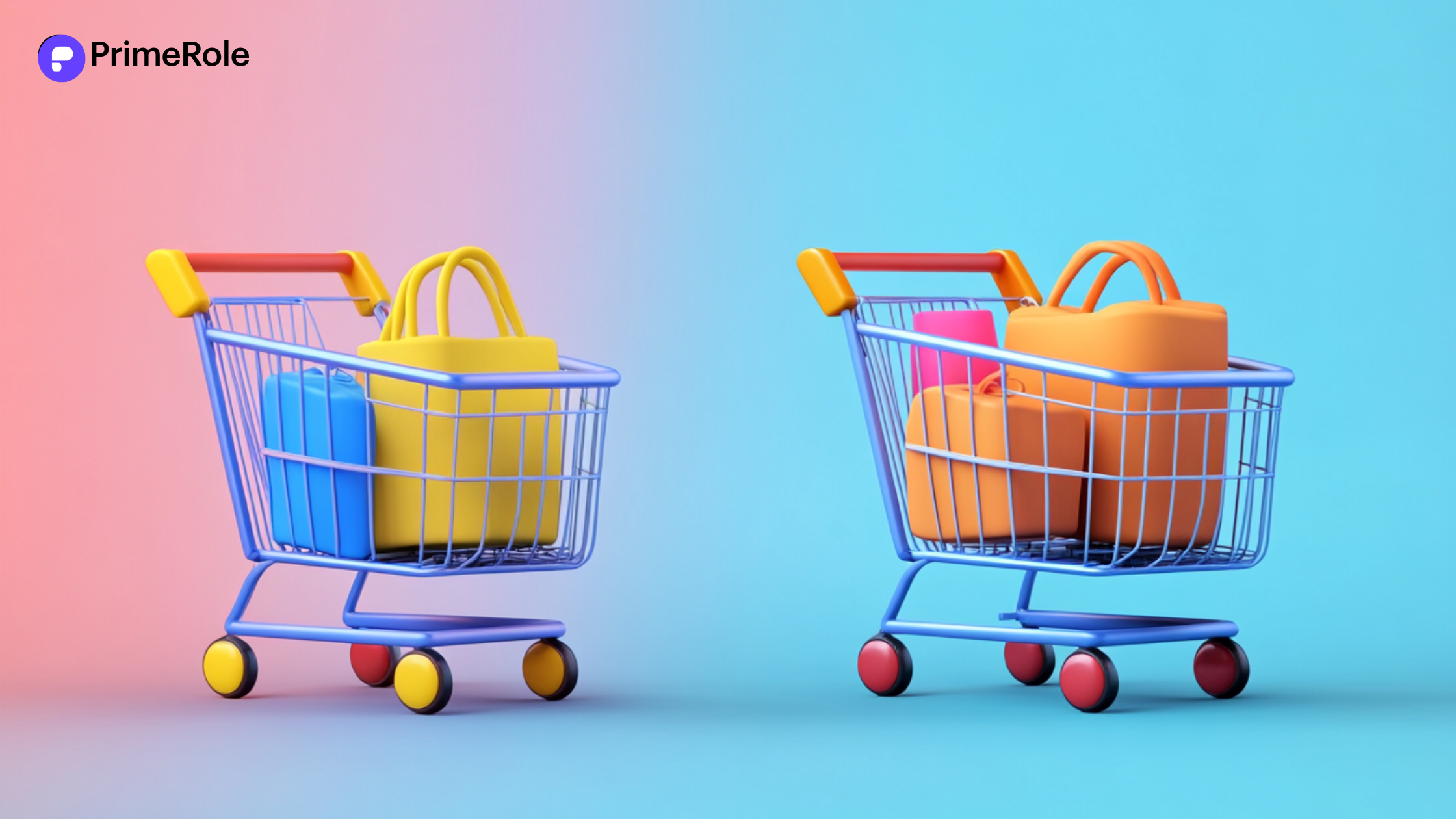
Whether you're propelling a startup or scaling a developing commerce, understanding your showcase opportunity isn't fair important—it's fundamental. It's the establishment of each key choice you make, from pitching to financial specialists to mapping out your showcasing and deals objectives.
But let’s be honest: market sizing can get a little overwhelming. Acronyms like TAM, SAM, and SOM are often thrown around in pitch decks and planning sessions, but not everyone knows what they really mean—or how to apply them in a way that drives real business outcomes.
At Primerole, we believe clarity is power. That’s why we’re zooming in on one of the most practical (and often misunderstood) metrics in market sizing: Serviceable Obtainable Market (SOM).
Unlike Total Addressable Market (TAM), which represents the entire potential demand for your product, and SAM (Serviceable Available Market), which narrows it down to the market you can actually serve—SOM is the sweet spot. It’s the realistic slice of the market you can capture right now, given your resources, team, reach, and competitive landscape.
Table of Contents:
- What is Serviceable Obtainable Market (SOM)?
- TAM vs. SAM vs. SOM: Breaking It Down
- Why SOM Matters?
- How to Calculate SOM?
- How to Increase Your SOM?
- Common Mistakes to Avoid
- Conclusion
- Serviceable Obtainable Market Frequently Ask questions (FAQs)
What is Serviceable Obtainable Market (SOM)?
The Serviceable Obtainable Market (SOM) refers to the portion of the market that your business can realistically capture, considering current resources, competition, and market reach. It is a subset of the Serviceable Available Market (SAM) and helps businesses estimate their short- to mid-term revenue potential in a realistic, grounded manner. While the Total Addressable Market (TAM) provides the broadest view of market demand, and SAM narrows it down to what your product or service can serve, SOM gets even more specific—it’s about what you can actually achieve with your current capabilities.
TAM vs. SAM vs. SOM: Breaking It Down?
| Aspect | TAM (Total Addressable Market) | SAM (Serviceable Available Market) | SOM (Serviceable Obtainable Market) |
|---|---|---|---|
| Full Form | Total Addressable Market | Serviceable Available Market | Serviceable Obtainable Market |
| Definition | The total demand for a product or service in the entire market, with no limitations | The portion of the TAM that your business can serve with its products/services | The share of SAM your business can realistically capture based on capabilities and reach |
| Scope | Broadest view – includes all potential customers across all markets | Narrowed down to your target customer base and reachable segments | Focused view – based on current business limitations, resources, and competition |
| Purpose | Understand total market potential | Identify the market segment your offering caters to | Set achievable revenue and customer acquisition goals |
| Used By | VCs, analysts, and high-level strategic planners | Product managers, marketers, and business strategists | Startups, sales teams, marketing teams, and investors for go-to-market planning |
| Calculation Basis | Industry data, market research, global or national data | Subset of TAM based on geographic, demographic, or product relevance | Subset of SAM based on realistic reach, market share assumptions, and current capacity |
| Data Sources | Industry reports, government data, analyst forecasts | Target market reports, customer demographics, product-market fit analysis | Internal business data, competitor analysis, market penetration forecasts |
| Strategic Relevance | Used for visionary planning and market opportunity sizing | Helps define the strategic product-market fit | Crucial for short- to mid-term planning, forecasting, and fundraising |
| Risk Level | High – includes untapped and unrealistic portions | Medium – more targeted but still includes optimistic assumptions | Low – focused on attainable goals within current limits |
| Market Entry Example | Global online food delivery market ($500B) | Online food delivery market in your country ($50B) | 5% share in your city/region ($2.5B) |
| Why It Matters | Shows total opportunity if all conditions were ideal | Highlights your potential within a realistic market area | Guides practical decisions, budgeting, and investor expectations |
| Update Frequency | Rarely updated unless market dynamics change drastically | Occasionally updated based on product improvements or geographic shifts | Frequently updated as your capabilities, competition, or market strategy evolves |
Why SOM Matters?
Understanding your Serviceable Obtainable Market (SOM) is more than just a number on a pitch deck—it's a strategic tool that impacts everything from your daily operations to your long-term vision.
1. Set Realistic Business Goals
Many startups make the mistake of aiming too high, too fast. By focusing on SOM, you’re not estimating how big your dream is—you’re estimating how much of it you can actually make real right now. It’s the difference between saying “We want 10 million users” versus “Given our resources, we can acquire 100,000 users in Year One.”
SOM gives you:- A grounded outlook to measure performance.
- Reasonable sales and marketing targets.
- A benchmark to evaluate progress without inflating expectations.
2. Secure Investor Confidence
Financial specialists have seen it all—especially unlikely showcase projections. By displaying a well-researched SOM, you communicate validity, commerce insight, and mindfulness of your restrictions.
What speculators need to see:- A clear way to income.
- An astute understanding of the competitive scene.
- A centered methodology based on achievable showcase fragments.
In brief, a strong SOM makes your pitch more powerful.
3. Allocate Resources Efficiently
When you're clear on your obtainable market, your strategy becomes more efficient. You won’t waste money targeting audiences who are out of reach or uninterested in your offering.
Smart SOM planning helps you:- Focus on high-converting segments.
- Optimize ad spend and marketing campaigns.
- Allocate your team where they can deliver the most value.
4. Plan Smarter Go-to-Market Strategies
With SOM, you can zero in on customer segments that are not only reachable but ready to buy. Whether you're launching in a specific city, targeting a niche market, or appealing to early adopters, SOM allows you to design marketing, sales, and product strategies around what's realistically possible.
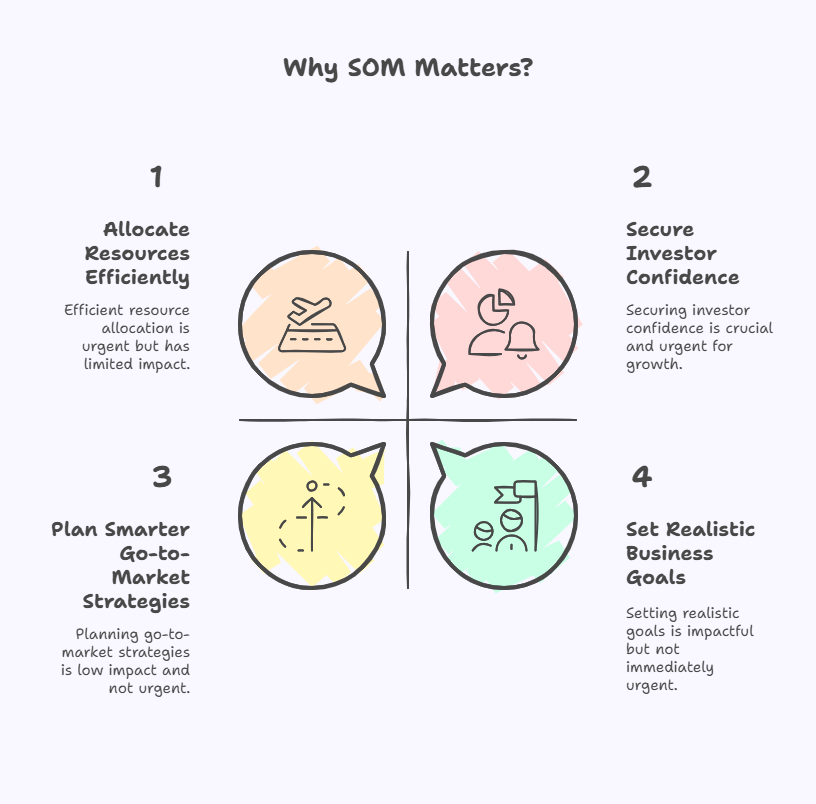
How to Calculate SOM?
Calculating your SOM doesn’t require a PhD in data science. It requires research, business logic, and a clear view of your market. Here’s how to do it:
Step 1: Define Your SAM (Serviceable Available Market)
Usually the parcel of the showcase your item or benefit can serve based on its current capabilities. You characterize your SAM by considering:
- Geographic scope: Where do you right now work?
- Socioeconomics: Who are your perfect clients?
- Product Fit: Does your item coordinate wants of this fragment?
- Cost Focuses: Can this gathering of people manage your item or benefit? Example: You run a meal subscription service. While TAM may include everyone who eats, your SAM would include working professionals in urban areas with disposable income.
Step 2: Estimate Your Market Share
How much of the SAM can you practically capture within the following 1–3 years?
This step is almost being brutally fair. Consider:
- Number of coordinate and roundabout competitors.
- Your showcasing budget and client-securing capacity.
- Brand mindfulness and current footing.
- Sources like competitor examination, client inquiries, and benchmarking comparable new businesses can direct you.
- Professional Tip: Dodge excessively hopeful surmises. A 100% share of SAM is once in a while practical.
Step 3: Apply the SOM Formula
SOM = SAM × Estimated Market Share Example:
- Your SAM is worth $10 million (based on your region and ideal customer profile).
- You estimate a 10% realistic share.
SOM = $10,000,000 × 10% = $1,000,000 So your Serviceable Obtainable Market is $1 million, which becomes the target revenue opportunity for your team.
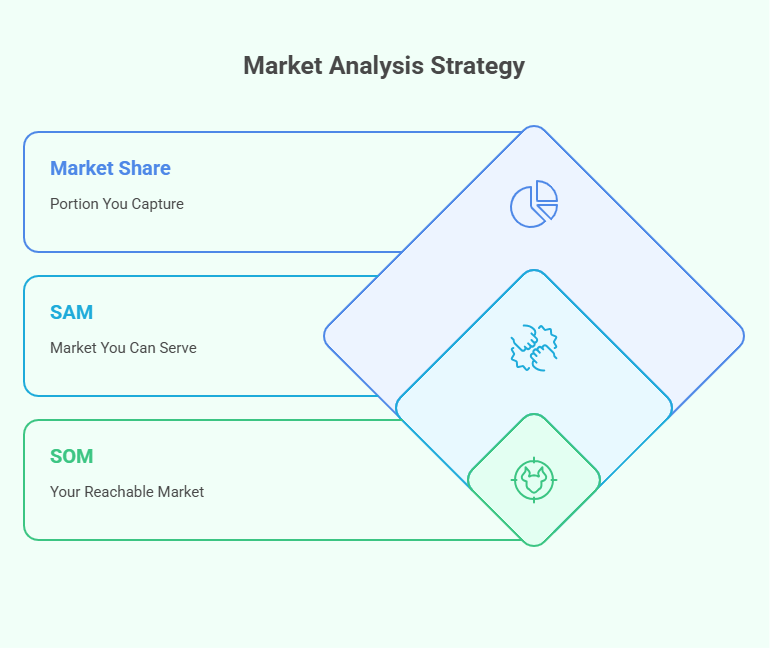
How to Increase Your SOM?
Capturing more of your serviceable market takes planning and growth-oriented strategies. Here’s how to expand your SOM in a sustainable way:
1. Enhance Your Product Offering
- Add features your competitors lack.
- Listen to customer feedback to address pain points.
- Improve user experience (UX) and reduce friction.
- The result? A more appealing product that wins over your SAM audience and pulls in undecided buyers.
2. Expand Geographically
On the off chance that you've immersed your starting locale, it's time to investigate modern markets. Explore for ranges with:
- Comparative client profiles.
- Less competition.
- Undiscovered request.
- Tip: Begin with adjoining cities or districts where operational development is doable.
3. Improve Your Marketing & Targeting
Better marketing directly affects your SOM. You can:
- Double down on SEO and content marketing to attract inbound leads.
- Use targeted advertising (e.g., Google Ads, LinkedIn Ads) to reach decision-makers.
- Refine your buyer personas for smarter outreach.
4. Form Strategic Alliances
Collaborate with complementary brands to cross-promote or bundle your offerings. Strategic partnerships can:
- Introduce your product to new audiences.
- Boost credibility.
- Reduce customer acquisition costs.
5. Invest in Exceptional Customer Service
Delight customers and they’ll:
- Stay longer (increasing LTV).
- Refer friends and colleagues.
- Share reviews and testimonials.
- Great service creates organic growth, which effectively increases your attainable market.
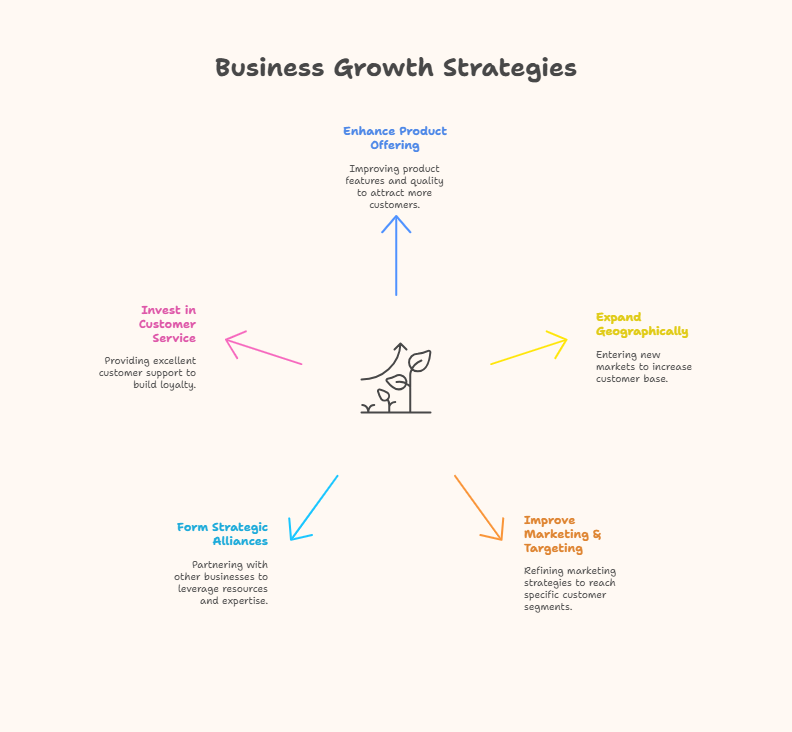
Common Mistakes to Avoid
Calculating your Serviceable Obtainable Market (SOM) can be a game-changer for business strategy—but only if done right. Many startups and growing companies fall into common traps that can throw off their entire business plan. Let’s dive into the key pitfalls and why you should avoid them:
1. Overestimating Your Market Share
What It Means: Assuming you’ll grab a large chunk of the market too quickly—like 30%, 50%, or even 100% of your SAM—without backing it up with realistic projections.
Why It’s a Problem: Overconfidence can inflate your SOM and misguide your growth strategy. You may overinvest in marketing or production expecting massive returns, only to face disappointment and wasted resources.
The Settle: Base your advertise share gauges on:
- Verifiable deals information.
- Case considers from comparable businesses.
- Reasonable promoting reach.
- Your budget and operational limits.
- Keep in mind: Indeed industry pioneers once in a while possess more than 10-20% of a showcase. Remain humble, and your arrange will be more grounded.
2. Neglecting the Competition
What It Means: Calculating your SOM as if your product or service exists in a vacuum—without considering who else is already serving your target customers.
Why It’s a Problem: Every market has competitors. If you don’t know who they are, what they offer, or how they price, you can’t truly estimate how much of the market is obtainable for your business.
The Fix: Conduct a thorough competitive analysis:
- Identify direct and indirect competitors.
- Compare pricing, features, positioning, and customer satisfaction.
- Use tools like SEMrush, SimilarWeb, or Crunchbase to get detailed insights.
- Knowing your competition helps define where you fit in—and how much market share is actually within reach.
3. Using Outdated or Inaccurate Data
What It Means: Building your SAM or SOM based on old reports, assumptions, or general industry benchmarks without verifying the relevance to your specific niche or geography.
Why It’s a Problem: The market changes fast—especially in industries like tech, retail, or consumer goods. Using outdated or generalized data can lead to:
- Inaccurate SOM numbers.
- Msguided strategies.
- Poor investor confidence.
The Fix: Use up-to-date, credible data sources such as:
- Government statistics (e.g., U.S. Census, Statista).
- Industry reports (Gartner, McKinsey, IBISWorld).
- Your CRM, customer feedback, or analytics.
- Third-party tools (Google Trends, market research surveys).
- Always validate the source and timestamp of your data.
4. Failing to Reassess and Update SOM
What It Means: Treating your SOM calculation as a one-time exercise rather than a living, breathing part of your strategy.
Why It’s a Problem: Markets evolve. Competitors enter and exit. Customer preferences shift. If your SOM doesn't reflect these changes, your growth plan will become outdated and misaligned.
The Fix: Revisit and update your SOM:
- Every 6–12 months.
- After major product launches.
- When entering new regions.
- After significant market shifts or new competitors emerge.
- Your SOM should evolve alongside your business. Staying agile will help you pivot quickly and stay competitive.
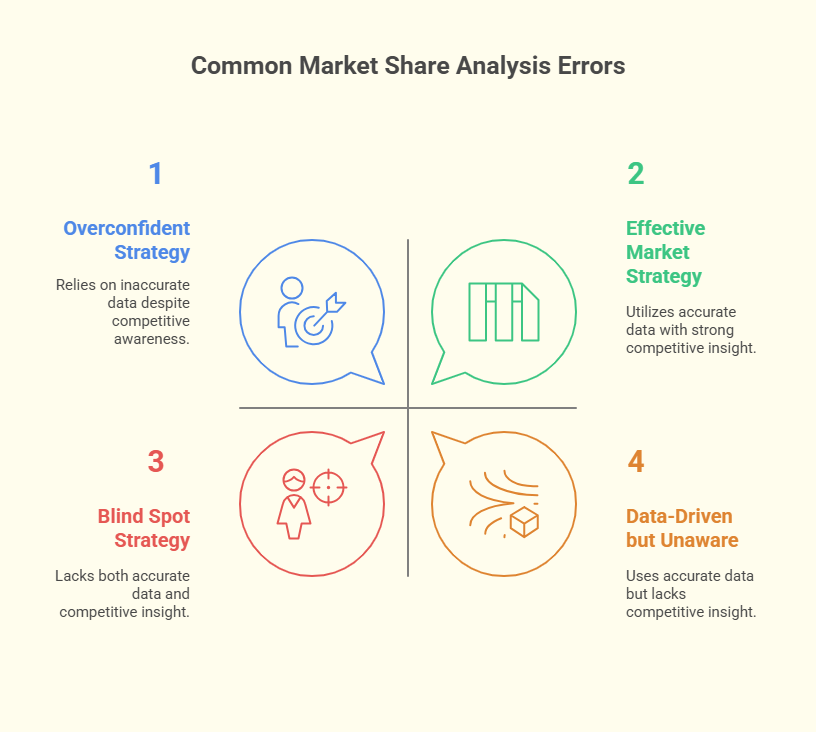
Conclusion
When you're planning the growth of your business, it's easy to get caught up in the excitement of huge market numbers — like the Total Addressable Market (TAM), which represents the entire demand for a product or service. But here’s the catch: just because a market is massive doesn’t mean your business can capture all or even a big chunk of it right away.
That’s where the Serviceable Obtainable Market (SOM) comes in. SOM is essentially the slice of the market that your business can realistically target and serve in the near term. It takes into account your current resources, competition, distribution channels, and marketing reach. Instead of dreaming big with TAM, focusing on SOM grounds your growth expectations in reality.
By calculating your SOM regularly, you get a clear picture of what’s actually achievable. This helps you avoid overextending your budget or manpower chasing unreachable targets. It also lets you prioritize your efforts on the customers you can serve well right now, which improves efficiency and increases your chances of success.
In commonsense terms, knowing your SOM implies you'll be able to set practical deal targets, distribute your promotion budget shrewdly, and arrange your item improvement with exactness. It's a vital instrument that makes a difference in how you develop reasonably — step by step.
In conclusion, whereas TAM gives you the “big picture” vision, SOM is your noteworthy guide. Companies like PrimeRole get the significance of adjusting development plans with achievable showcase openings. By centering on your SOM, you guarantee that each move you make is supported by strong information and reasonable objectives, clearing the way for relentless and feasible victory.
Target the Right Market with Precision!
Understand your Serviceable Obtainable Market (SOM) to focus your efforts where they matter most.
Serviceable Obtainable Market Frequently Ask questions (FAQs)
How does SOM differ from TAM and SAM?
TAM is the total market demand. SAM is the portion of TAM you can serve. SOM is the portion of SAM you can realistically capture.
Why is SOM important for startups?
It helps in setting achievable goals, attracting investors, and allocating resources effectively.
Can SOM change over time?
Yes, as your business grows and market conditions evolve, your SOM can increase or decrease.
